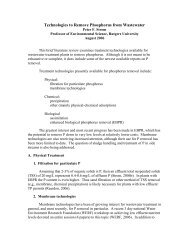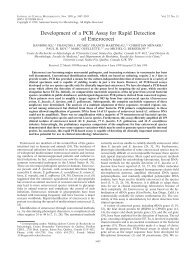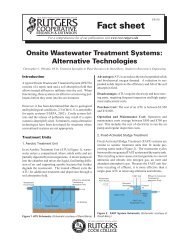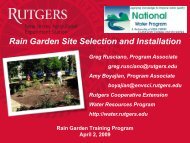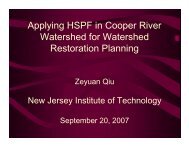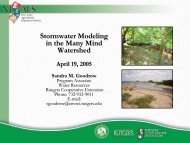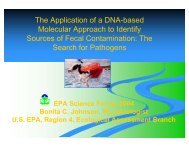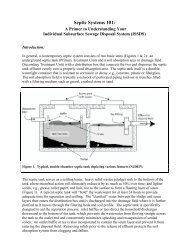Quality Assurance Project Plans - Rutgers Cooperative Extension ...
Quality Assurance Project Plans - Rutgers Cooperative Extension ...
Quality Assurance Project Plans - Rutgers Cooperative Extension ...
- No tags were found...
Create successful ePaper yourself
Turn your PDF publications into a flip-book with our unique Google optimized e-Paper software.
<strong>Quality</strong> <strong>Assurance</strong> <strong>Project</strong><strong>Plans</strong>Watershed Plan ConferenceJanuary 19, 2007Pat Rector,Principal Env. Specialist,Bureau of WatershedPlanning
WATERSHEDRESTORATION &PROTECTION PLANS• Data Gaps• Biological• Bacteriological• Chemical• Physical• Data <strong>Quality</strong>• <strong>Quality</strong> <strong>Assurance</strong> <strong>Project</strong> <strong>Plans</strong> (QAPP)• Certification• QAPP approval• DWM Process
What is a <strong>Quality</strong><strong>Assurance</strong> <strong>Project</strong> Plan?• “…QAPPs define data qualityobjectives, and specify the fieldsampling protocols, field survey,and laboratory analytical methodsand procedures to be implementedin the project.” (OQA 2003-4)• “blueprint by which individualprojects involving environmentaldata are implemented andassessed.”(OQA 2003-4)
Available QAPP Guidance• EPA Requirements for QA <strong>Project</strong> <strong>Plans</strong> (QA/R-5)(www.epa.gov/quality/ )• Guidance on <strong>Quality</strong> <strong>Assurance</strong> <strong>Project</strong> <strong>Plans</strong>(QA/G-5) Feb. 1998 USEPA• Guidance for the Development of <strong>Quality</strong><strong>Assurance</strong> <strong>Project</strong> <strong>Plans</strong> for Environmentalmonitoring <strong>Project</strong>s” April 12, 2004, USEPARegion II• OQA on-linehttp://www.state.nj.us/dep/oqa/index.html• 319(h) QAPP Guidance NJDEP, DWM website• Voluntary Monitoring Program(http://www.state.nj.us/dep/watershedmgt/volunteer_monitoring.htm )
Components of a QAPP• Title/Approval Sheet• Table of Contents• Distribution List• <strong>Project</strong>/Task Organization• Special Training Needs/Certification• Problem Definition• <strong>Quality</strong> Objectives• Field Monitoring Requirements• Analytical Requirements• Sample Handling and Custody Requirements• Calibration Requirements• Corrective Actions• Data Management• Data Review, Validation• Reporting
Synoptic monitoring• Help define and locate mostsevere water quality problemsin the watershed• Help support identification ofspecific major causes• Short duration• Potential for inaccurate results(weather, intermittentdischarges, etc.)• Random site selection toanswer broad questions
Fate and transport monitoring• Help definesources andcauses• Intensivesampling overshort time, andlimitedgeographic area• Targeted manner(resourceconcerns)
Follow-up monitoring• To determine if waterquality improvementsare being achievedfollow-up monitoringshould be conducted.• Monitoring stations andparameters should beevaluated to determinefuture monitoringneeds.
Certification or approval?• Laboratories are certified forparticular parameters annuallythrough OQA• To verify information on laboratorycertification NJDEP OQA or DEP’sData Miner• In-situ field monitoring is considered afield lab and therefore also requirescertification through OQA• Methodologies for chemical/bacteriaanalysis are approved through OQA• Sampling plan is approved throughDWM.
DWM QAPP ReviewProcess• <strong>Project</strong> Manager• QAPP coordinator• Other review (e.g. TMDL, Biological)• Review focuses on the ability of thesampling plan to provide informationon the sources of pollution and theareas for restoration.• Revisions and submission to MarcFerko, Office of <strong>Quality</strong> <strong>Assurance</strong>
Audits and corrective actions• The 319(h) grant RfP states thatan approved QAPP is necessaryfor water quality monitoring,based on EPA requirements.• As part of the QAPP the granteeagrees to field audit.• If corrective action is necessarythat needs to be spelled out anddistributed.
Sampling?Need a plan!• Chemical• Biological• Bacteriological• Physical
Location, Location, Location
Field sampling• Majority of sampling will be collectionand transport of samples to a certifiedlab.• Sampling must be in accordance withapproved sampling methodologies(Field training manual)• Field training manual is a largedocument, when it is cited, the sectionreferenced should be included.
QAPP Guidance 319(h)RfP
Chemical• TMDL?• Nutrient• Conventionals• Sampling in accordance with the2006 Integrated List Methodology(http://www.state.nj.us/dep/wmm/sgwqt/wat/integratedlist/integratedlist2006.html )
Biological• EPA Rapid Bioassessment• 10% <strong>Quality</strong> Control Check toindependent lab• Methodology is Resourceintensive, pick sites carefully• Chemical, visual and physicalsampling (i.e. TSS, flow)
Bacteriological• The Surface Water <strong>Quality</strong> Standards(NJSWQS) have changed from fecal coliformto E. coli in freshwater and enterococcus insaline waters (N.J.A.C. 7:9B)• http://www.state.nj.us/dep/wmm/sgwqt/200610swqs.pdf• Therefore, all bacteria monitoring willinclude e. coli or enterococcus asapplicable.• In streams with a fecal coliform TMDL adecision will be made whether to includeboth fecal coliform and e. coli or only e. colion a case-by-case basis.
Trackdown• On-the-ground information is critical.• Trackdown is a weight of evidenceapproach.• Visual Assessment protocol can befound on the Volunteer MonitoringWebsite• At this time the Department has notapproved certain methodologies (forexample qPCR) pending validation ofthe results.
Physical• Flow – In order to determine loadsflow must either be measured orcalculated.• Although there is not acertification process for flowmonitoring at this time, theDepartment will review flowmonitoring as part of the QAPP.• It must be included as part of theQAPP and will be reviewed foracceptable techniques.
Data submission• Data will be submitted to theproject manager on a CD inusage format, with the approvedQAPP and cover sheet, alongwith narrative explanation as toany data considerations (i.e. aparticular datum point will notbe utilized in analysis due tosuspected contamination ofsample).
Questions?
Available QAPP Guidance• EPA Requirements for QA <strong>Project</strong> <strong>Plans</strong>(QA/R-5) (www.epa.gov/quality/ )• Guidance on <strong>Quality</strong> <strong>Assurance</strong> <strong>Project</strong><strong>Plans</strong> (QA/G-5) Feb. 1998 USEPA• Guidance for the Development of <strong>Quality</strong><strong>Assurance</strong> <strong>Project</strong> <strong>Plans</strong> forEnvironmental monitoring <strong>Project</strong>s” April12, 2004, USEPA Region II• 319(h) QAPP Guidance NJDEP, DWMwebsite• Voluntary Monitoring Program(http://www.state.nj.us/dep/watershedmgt/volunteer_monitoring.htm )• OQA on-linehttp://www.state.nj.us/dep/oqa/index.html



